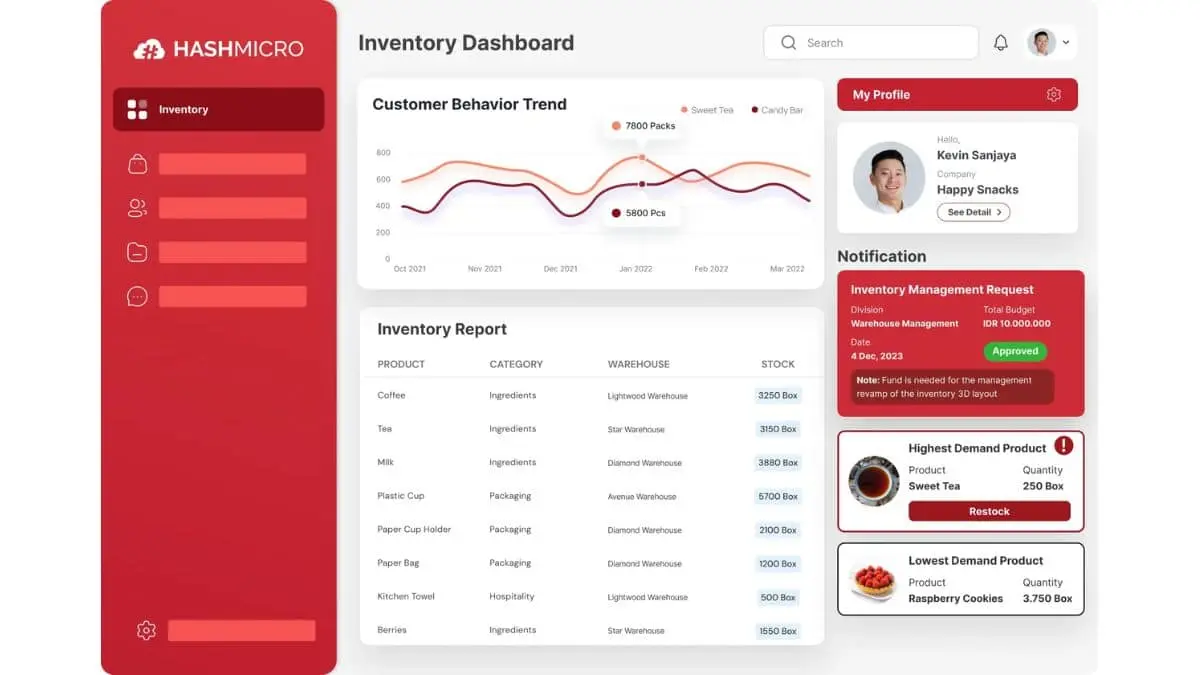Are you aware of the significant risks that inventory overstock and understock pose to your business? Overstocking can lead to substantial financial losses due to excess capital tied up in unsold goods. Similarly, understocking can result in unmet customer needs, diminishing their trust in your brand and potentially leading to further losses.
Proper inventory management is crucial to prevent these scenarios and maintain a healthy balance that aligns with market demand, ensuring both customer satisfaction and financial stability. Therefore, this article will discuss more about inventory overstock and understock, as well as how to prevent it.
Key Takeaways
|
Table of Contents

Difference Between Inventory Overstock and Understock
When discerning what overstock is, it typically refers to situations where a business holds more inventory than what is currently required to meet customer demand. This condition, also identified as excessive stock or excess inventory, can lead to surplus situations that burden the company with unnecessary costs.
Conversely, understock occurs when your inventory levels are too low, failing to satisfy the market demand. This shortage can result in missed sales opportunities and can negatively impact customer satisfaction, as immediate needs cannot be adequately met.
Both excess inventory and insufficient stock can act as barriers to business growth, as they each can lead to lost revenue and cost inefficiencies. To help illustrate these contrasts further, the following table compares critical aspects of overstock and understock:
| Aspect | Overstock (Excessive Stock) | Understock |
| Cash Flow Impact | Negative effect as capital is tied up in excess inventory. | Potential lost revenue due to inability to meet consumer demand. |
| Storage Costs | Increases as excess stock requires more space. | Reduced, but risk of stock-outs increases. |
| Risk to Business | Risk of obsolescence and increased holding costs. | Risk of missed sales opportunities and customer dissatisfaction. |
| Response Strategy | Consider clearance sales, discounts, or return to suppliers. | Enhance demand forecasting and reorder point calculations. |
Grasping the difference between excess stock and inventory shortages allows you to adopt more informed strategies that align with your business’s operational goals and market demand, fostering a more agile and responsive business environment.
Consequences of Inventory Overstock and Understock
Effective inventory control is essential for maintaining profitability and customer satisfaction in any business. When inventory is poorly managed, it can lead to significant issues, such as overstock or understock, each with distinct and damaging consequences.
Let’s explore the impacts that might happen if you’re experiencing overstock in detail:
- Financial Implications: Holding too much inventory ties up capital that could be used in other areas of your business. Additionally, overstock can lead to product obsolescence, where products may no longer be relevant or in demand, leading to potential sales losses.
- Obsolescence and Spoilage: Excess inventory risks becoming obsolete or perishable goods spoiling, leading to financial loose.
- Increased Holding Costs: Overstock leads to higher storage costs, including warehousing, insurance, and security. It also ties up capital that could be used for other business activities.
- Increased Risk of Markdowns: Excess inventory often leads to discounting or markdowns to clear space, eroding profit margins.
- Sales Impact: Excessive stock levels often result in lost sales because products become unnecessary or outdated before they are sold.
Then, understock also has fatal impacts on your business as explained below:
- Financial Implications: Understocking can lead to higher costs due to the need for expedited shipping and rushed orders to quickly replenish stock levels.
- Customer Experience: Failing to meet demand promptly can frustrate customers, damage their loyalty, and drive them to seek alternatives from your competitors.
- Sales Impact: Immediate sales opportunities are lost when products are unavailable, and there is a risk of permanently losing customers to competitors if understock issues persist.
These consequences underline the critical need for precise inventory management strategies to prevent financial strains and protect customer relationships. Proper inventory management ensures that you have just enough stock to meet demand without excess, maintaining your business’s operational efficiency and market competitiveness.
Factors of Inventory Overstock

Several factors can lead to overstock situations, each requiring careful consideration to prevent unnecessary financial strain. Here are five key factors that contribute to inventory overstock:
- Inaccurate Demand Forecasting: Misestimating customer demand leads to purchasing more stock than needed, causing an overflow in inventory that may not sell.
- Poor Inventory Tracking: Without effective tracking systems, businesses can lose sight of what is already in stock, resulting in repetitive ordering or purchasing excess items.
- Extended Lead Times: Anticipating long supplier lead times might prompt businesses to order large quantities in advance. If market demands shift unexpectedly, this can result in surplus stock.
- Seasonal Overestimation: Companies sometimes overestimate the amount of inventory required for seasonal sales boosts. When the season wanes, they are left with unsold products.
- Bulk Purchase Discounts: Attractive discounts on bulk purchases can tempt businesses to buy more inventory than necessary, especially if the cost savings appear significant compared to the storage and potential wastage costs.
Factors of Inventory Understock
Effective inventory management not only prevent overstock but also guards against understock. Understocking can be detrimental, leading to missed sales opportunities and weakened customer relationships.
Here are five key factors that contribute to inventory understock:
- Just-in-Time Ordering Pitfalls: Relying heavily on just-in-time inventory systems can lead to understock if there are unexpected delays in the supply chain or sudden spikes in demand that weren’t anticipated.
- Inefficient Reorder Processes: If the reorder processes are not streamlined or automated, it can result in delays in restocking, leaving shelves empty for longer periods.
- Supplier Reliability Issues: Dependence on suppliers who fail to deliver goods on time or who often encounter stock shortages themselves can directly impact your inventory levels.
- Unforeseen Demand Increases: Sudden increases in product demand, possibly due to market trends or promotional successes, can deplete stock faster than anticipated, leading to understock situations.
- Inadequate Inventory Analysis: Failing to do an inventory analysis to understand sales patterns and stock needs can result in insufficient stock levels, especially for high-demand items.
How to Avoid Inventory Overstock and Understock

Successfully managing inventory is a critical aspect of running a business that cannot be overlooked. Balancing the fine line between too much and too little stock requires strategic planning and the adoption of robust processes. Here are key strategies to prevent both overstock and understock, ensuring your inventory
levels are just right to meet demand without excess:
- Implement Demand Forecasting Tools: Utilize advanced forecasting techniques and tools to predict customer demand more accurately.
- Enhance Supply Chain Visibility: Improve visibility throughout your supply chain to quickly adapt to supply variations and demand changes.
- Set Reorder Points: Establish clear reorder points based on historical sales data and current market trends to maintain optimal stock levels.
- Regularly Review Inventory Data: Conduct frequent reviews of your inventory performance to identify and rectify potential issues before they result in overstock or understock.
- Streamline Supplier Communication: Develop strong relationships with reliable suppliers and maintain open lines of communication to ensure timely delivery of goods.
To streamline these processes and reduce the risk of inventory mismanagement, adopting inventory management software is an invaluable step. In the next section, we will learn about the impact of inventory management software for managing your inventory.
You can also start calculating the right software price to support the seamless operation of your inventory by clicking the banner below.
Avoid Inventory Overstock and Understock with Inventory Management Software

Enhancing your operational efficiency in the Philippines through the integration of inventory automation and advanced software solutions can dramatically streamline your business operations. By adopting inventory management software, you can avoid the pitfalls of overstock and understock, ensuring your inventory levels are precisely managed to align with your business needs.
One of the best options available in the Philippines is HashMicro. HashMicro offers comprehensive software solution with complete modules and features, allowing any businesses to maximize the efficiency of their inventory level. Trusted by more than 1750 company from various industries, HashMicro ensures the best quality and customer experience for its software.
Below are the key features of HashMicro inventory management software that can help any businesses to avoid overstock and understock issues.
Run Rate Reordering Rules
Implementing run rate reordering rules through your inventory management software further secures your operational efficiency. These rules automate the replenishment process based on actual sales velocity, ensuring you maintain a balanced stock level that consistently meets consumer demand without overcapitalizing.
Stock Forecasting
Software tools designed for stock forecasting empower you with data predictions that guide your stock management strategies. By analyzing historical sales data and market trends, these software solutions ensure you are better equipped to meet customer demand without the excess cost associated with overstock.
Stock Optimizer per Warehouse
Optimization per warehouse is another critical feature enabled by inventory management software. This functionality supports your decision-making by providing tailored recommendations for each warehouse location, enhancing your inventory distribution and reducing unnecessary stock transfers between locations.
Replenishment of Product with Multiple Action
The software’s replenishment capabilities offer a dynamic approach to managing stock levels. With features that allow multiple actions like auto-reordering, you can maintain optimal stock levels efficiently. This proactive measure prevents stockouts and overstock incidents by adjusting your inventory in real time.
RFID Warehouse Rack Stock In-Out Automation
RFID technology integrated into inventory management systems provides real-time tracking of stock movements within your warehouses. This automation enhances the accuracy of your inventory records and significantly speeds up the process of checking in and distributing stock.
Conclusion
Mastering inventory balance is essential for your business to flourish, ensuring both operational efficiency and the upkeep of customer satisfaction. The journey towards this mastery begins with a clear understanding of how overstock and understock can impact your company’s performance.
Adopting an advanced inventory management software system can significantly streamline your ability to maintain this balance. This technology gives you a proactive, data-informed edge, letting you skillfully predict and respond to the ever-changing needs of the market.
When you’re thinking about implementing an inventory management software, think of HashMicro as the best option in Philippines. As it provides many benefits for your company to grow, it also offers a free demo service. Grab the chance to streamline your inventory management to the next level!







































































